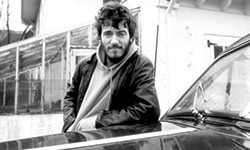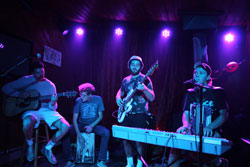Ed Gallucci, a University alumnus and famous photographer best known for his photographs of Bruce Springsteen and Muhammad Ali, among other well-known names, visited the University on October 2. Many of Gallucci’s most famous works are on display in Pollak Gallery in an exhibit considered to be a companion piece to September’s Springsteen Symposium. It is open to the public. The photos on display include a reel of photos featuring Bruce Springsteen, taken in 1972, photographs of Muhammad Ali on a car ride with Gallucci, a few photos of Taj Mahal, and even a picture of John Madden. The gallery also hosted pictures of several other famous names who Mr. Gallucci photographed.
Gallucci was born in Brooklyn, New York in 1947. Graduating from the Kansas City Art Institute in Missouri, he majored in graphic design with a minor in photography. Despite it being his minor, photography became one of Ed Gallucci’s main passions.
As he saved money for the equipment he required for professional photography, Gallucci rode taxi cabs to and from work each day, taking photographs of people walking by. He mentioned that these photographs are some of his favorite shots because every person in each photo was in their natural state. No pre-setup was arranged for a photo shoot, no plans were created. He only photographs everyday life.
Gallucci never used flash when photographing his subjects, claiming that flash is a photographer’s prime enemy. Most of his photographs were shot in black and white, with color only being used sometimes when indoors.
During the 60’s and 70’s, some of his famous works were published in a magazine called “Crawdaddy!”, a hit rock and roll magazine describing itself as, “the first magazine to take rock and roll seriously.” As the description implies, the magazine featured opinions and criticism of early and rising rock and roll stars such as Bruce Springsteen, The Who, Eric Clapton, The Rolling Stones, and more. The magazine also eventually featured actors, athletes and other famous celebrities of whom Mr. Gallucci photographed, although not as many as the number of musicians which appeared in each issue of “Crawdaddy!”.
During the presentation, many of Gallucci’s most famous photographs were shown, hosting a bevy of well-known names and music artists. His featured subjects include: Rod Stewart & Faces, Paul Butterfield, Taj Mahal, Peter Knobler, The Flying Burrito Brothers, Jerry Garcia, Blood Sweat & Tears, Traffic, Stevie Windwood, Jim Capaldi, Dave Mason, Loudon Wainwright III, Bruce Springsteen & E St. Band, Muhammad Ali, Chicago, Al Green, Martin Mull, Woody Allen, Stevie Wonder, Happy & Artie Traum, Paul Simon, Eubie Blake, John Cassavettes, Robert Altman, Scott Baio, Bill Wohrman, Jack Scalia, Frank Perdue, and John Madden.
Springsteen was a big draw for many attendees. According to Vaune Peck, Counselor and Coordinator of Arts Programming and Promotion, “The center portion of the Pollak Gallery focuses on Springsteen and the E Street Band during the 1970’s right before his career skyrocketed while the remaining images feature many other musicians and celebrities from the same era which lends some historical context.” Peck continued, “Attendees of the three day Springsteen Symposium really enjoyed the exhibit. Center for the Arts patrons always enjoy viewing exhibitions prior to attending events in Pollak Theatre…This particular exhibit perfectly complements our concert offerings.”
Gallucci gave an overview of which subjects he shot photos of, where the photographs were shot, and the techniques he used to shoot his subjects. The place where the photographer stands may be just as important as where the subject stays for the photo. Gallucci mentioned that while shooting famous names like Bruce Springsteen or other artists, he made sure to stay quiet and be unnoticed when shooting, so that every shot is natural and the subject does not feel forced. If a subject feels forced into taking a photo, they may be more reluctant to stay for the shot, or they may strike a pose which does not appear natural.
Gallucci’s stance on how to take a photograph is one that is very successful, as proven by his works. Many of his photographs are clear, crisp and full of detail in every photo, making each shot a pleasure to view.
Gallucci also touched upon the often-spoken debate between digital and traditional photography. Like many photographers before him, he mentions, “Digital photography takes the learning out of photography…Film photography teaches you.”
Toward the end of the presentation, an audience member asked Gallucci a question, “Was there any manipulation done to the photos that were shown to us tonight?” Gallucci responded that only very minor things had been done to the photos to make them more presentable on a larger screen.
To any viewer, this has to be perceived as very remarkable. Here are photos taken nearly forty years ago which still, to this day, appear very smooth and pleasing to the eye. A remarkable feat for any photographer is the long-lasting effect of his or her photographs, and Gallucci succeeds in this regard.
According to Peck, Gallucci is donating 36 images to Monmouth’s permanent collection. He is also donating 20 percent of sales from the exhibition to the university’s scholarship fund. Limited edition prints are available through Peck’s office, prices start at $800. Contact Peck’s office at (732) 571-3554 for more information.
IMAGE TAKEN from monmouth.edu




